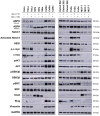Heterogeneous Response of Tumor Cell Lines to Inhibition of Aspartate β-hydroxylase
- PMID: 38817852
- PMCID: PMC11134442
- DOI: 10.7150/jca.94452
Heterogeneous Response of Tumor Cell Lines to Inhibition of Aspartate β-hydroxylase
Abstract
Background: Cancer development involves alterations in key cellular pathways, with aspartate β-hydroxylase (ASPH) emerging as an important player in tumorigenesis. ASPH is upregulated in various cancer types, where it promotes cancer progression mainly by regulating the Notch1 and SRC pathways. Methods: This study explored the responses of various human cervical, pharyngeal, and breast tumor cell lines to second- and third-generation ASPH inhibitors (MO-I-1151 and MO-I-1182) using proliferation, migration, and invasion assays; western blotting; and cell cycle analysis. Results: ASPH inhibition significantly reduced cell proliferation, migration, and invasion and disrupted both the canonical and noncanonical Notch1 pathways. The noncanonical pathway was particularly mediated by AKT signaling. Cell cycle analysis revealed a marked reduction in cyclin D1 expression, further confirming the inhibitory effect of ASPH inhibitors on cell proliferation. Additional analysis revealed G0/G1 arrest and restricted progression into S phase, highlighting the regulatory impact of ASPH inhibitors on the cell cycle. Furthermore, ASPH inhibition induced distinctive alterations in nuclear morphology. The high heterogeneity in the responses of individual tumor cell lines to ASPH inhibitors, both quantitatively and qualitatively, underscores the complex network of mechanisms that are regulated by ASPH and influence the efficacy of ASPH inhibition. The effects of ASPH inhibitors on Notch1 pathway activity, cyclin D1 expression, and nuclear morphology contribute to the understanding of the multifaceted effects of these inhibitors on cancer cell behavior. Conclusion: This study not only suggests that ASPH inhibitors are effective against tumor cell progression, in part through the induction of cell cycle arrest, but also highlights the diverse and heterogeneous effects of these inhibitors on the behavior of tumor cells of different origins.
Keywords: AKT signaling; ASPH inhibitors; Notch pathway; cell cycle; heterogeneity; tumorigenesis.
© The author(s).
Conflict of interest statement
Competing Interests: The authors have declared that no competing interest exists.
Figures






Similar articles
-
Aspartate β-hydroxylase promotes pancreatic ductal adenocarcinoma metastasis through activation of SRC signaling pathway.J Hematol Oncol. 2019 Dec 30;12(1):144. doi: 10.1186/s13045-019-0837-z. J Hematol Oncol. 2019. PMID: 31888763 Free PMC article.
-
ASPH-notch Axis guided Exosomal delivery of Prometastatic Secretome renders breast Cancer multi-organ metastasis.Mol Cancer. 2019 Nov 7;18(1):156. doi: 10.1186/s12943-019-1077-0. Mol Cancer. 2019. PMID: 31694640 Free PMC article.
-
Aspartate β-hydroxylase Regulates Expression of Ly6 Genes.J Cancer. 2024 Jan 1;15(5):1138-1152. doi: 10.7150/jca.90422. eCollection 2024. J Cancer. 2024. PMID: 38356711 Free PMC article.
-
Aspartate β-hydroxylase as a target for cancer therapy.J Exp Clin Cancer Res. 2020 Aug 18;39(1):163. doi: 10.1186/s13046-020-01669-w. J Exp Clin Cancer Res. 2020. PMID: 32811566 Free PMC article. Review.
-
Diverse molecular functions of aspartate β‑hydroxylase in cancer (Review).Oncol Rep. 2020 Dec;44(6):2364-2372. doi: 10.3892/or.2020.7792. Epub 2020 Oct 6. Oncol Rep. 2020. PMID: 33125119 Free PMC article. Review.
Cited by
-
Integrative Analysis of Radiation-Induced Senescence-Associated Secretory Phenotype Factors in Kidney Cancer Progression.Genes (Basel). 2025 Jan 15;16(1):85. doi: 10.3390/genes16010085. Genes (Basel). 2025. PMID: 39858632 Free PMC article.
-
ASPH Is a Metastatic Factor and Therapeutic Target in Chondrosarcoma.Cancers (Basel). 2025 Mar 12;17(6):951. doi: 10.3390/cancers17060951. Cancers (Basel). 2025. PMID: 40149287 Free PMC article.
References
-
- Greve JM, Pinkham AM, Cowan JA. Human aspartyl (asparaginyl) hydroxylase. A multifaceted enzyme with broad intra- and extra-cellular activity. Metallomics. 2021;13:mfab044. - PubMed
-
- Dinchuk JE, Henderson NL, Burn TC. et al. Aspartyl β-hydroxylase (Asph) and an evolutionarily conserved isoform of Asph missing the catalytic domain share exons with junctin. J Biol Chem. 2000;275:39543–54. - PubMed
-
- Engel J. EGF-like domains in extracellular matrix proteins: Localized signals for growth and differentiation? FEBS Lett. 1989;251:1–7. - PubMed
LinkOut - more resources
Full Text Sources
Research Materials
Miscellaneous

